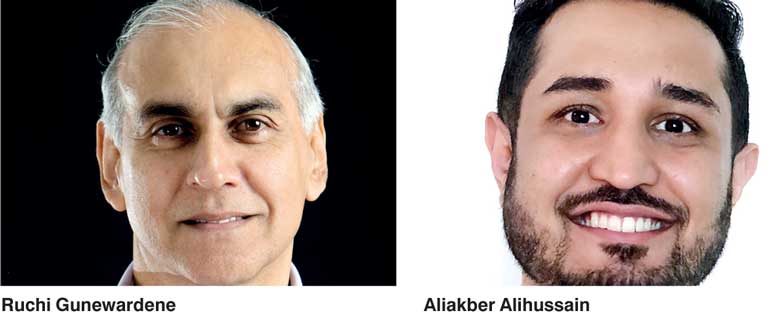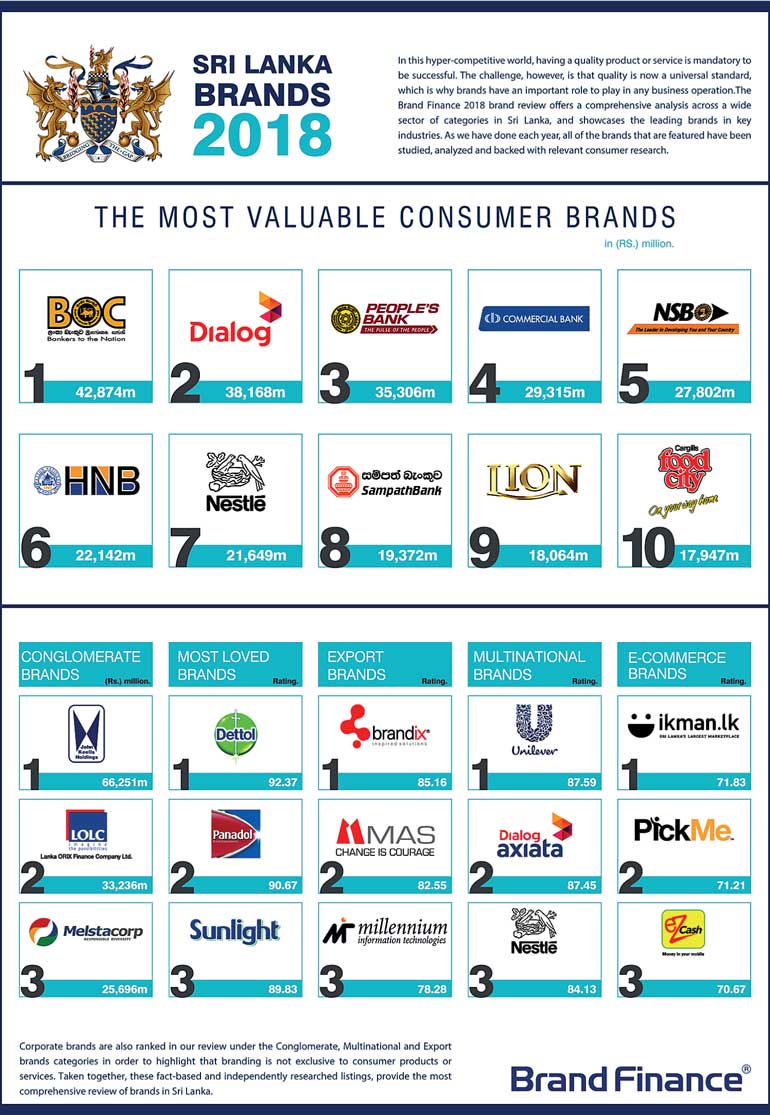Sunday Jan 18, 2026
Sunday Jan 18, 2026
Monday, 9 April 2018 00:00 - - {{hitsCtrl.values.hits}}

This year’s launch of Brand Finance’s most valuable and strongest brands in Sri Lanka, which is published in LMD’s Brands Annual, provides a comprehensive review of the brand landscape of the country. Being the 15th consecutive publication, in addition to the main 100 most valuable consumer brands, in this issue a separate analysis and listing of the top 20 most valuable conglomerate brands has been included, as a nod to the biggest businesses which are listed on the Colombo Stock Exchange.
With a view to the future, another feature in this year’s analysis is a look at the emerging e-commerce brands in Sri Lanka, which is based on the exclusive consumer research conducted for Brand Finance. These are the future brands which will likely overtake the brick and mortar businesses. On maturity, if these businesses eventually list their shares, these brands will upend the most valuable brands on our table, as has already happened across the world.
The most valuable global brands are now all led by technology companies: Amazon, Apple, Google, Samsung and Facebook in that order of priority, replacing the traditional brands such as Coca-Cola, GE, Citibank and Walmart, for example.
Overview of the most valuable consumer brands
The total value of Sri Lanka’s most valuable consumer brands increased by 14% in 2018 over 2017, whilst reaching a landmark combined brand value of a half a trillion rupees.
This upward swing is taking place in the context of a relatively volatile economic backdrop with the Central Bank predicting a relatively low growth rate of 3.1% in 2017, but which is expected to increase in 2018. Whilst the prolonged drought had an impact on the slow growth, a major drawback for the economy is the anaemic Foreign Direct Investment.
At the top of the most valuable consumer brands table, in line with the trend over the last five years, is BOC with a brand value of Rs. 43 billion, an increase of 5.6% from last year.
Similar to last year, No. 2 ranked Dialog made significant inroads edging towards leading the table, by growing its brand value by 12%. The brand is one of only two triple A rating in the Sri Lanka consumer 100, which is a testament to its robust brand management system and is the evidence for the trust placed by consumers for its quality products and services. The Dialog brand is represented in all its product portfolios such as mobile, fixed telephony, broadband and television operations.
In our view Dialog is setting the trend similar to the companies in the Brand Finance Global 500 rankings on which technology brands took the top five spots in 2018 for the very first time. This indicates that for a business to be sustainable in the new digital age, it needs to evolve and embrace technology as these brands are rapidly overtaking the old legacy brands and changing the business and brand landscape.
Another significant factor in our table is that banking brands dominate the top six of the 10 brands in Sri Lanka with a combined brand value of Rs. 177 billion, which is 35% of the overall brand value.
Just the top 10 brands contribute 54% of the total brand value while the bottom 50 brands contribute just 6%. This shows the lopsided nature of our brand lanscape. Apart from brand value, there is a notably lower brand strength index as well amongst those at the bottom of the table.
This indicates that many of the brands in the bottom half have much work to do on their brand. A common misconception is this means they need to invest in marketing and advertising, which is not the case. There is much that a company can do to make the brand an integral part of its decision making processes in the business (and not merely relegate it to the marketing department) which can positively impact the actions of the company and its performance.
The decline of SriLankan Airlines
One of the biggest declines in brand value on our table this year is SriLankan Airlines which has dropped from a high of seventh position last year to 13th in our rankings with a value decline of 42%. This is due to the impact of poor mismanagement and financial performance that has hampered the airline continuously over the last six to seven years.
Whilst the controversy of SriLankan Airlines has publicly raged on for several years now, the question that has been asked of us is, if the airline is not profitable and is in a severe debt crisis, how can the brand command any value at all?
The simple fact is that the airline continues to secure a steady stream of revenue of Rs. 136 billion on an annual basis. This makes SriLankan Airlines one of the highest revenue generating companies in Sri Lanka. The ability to attract significant revenue for the business has to be recognised and is achieved through a variety of means. These include having a monopoly which it enjoys in the country, the international landing rights it has secured, the strategic location of the country in relation to global travel, and the brand affinity that customers have and enjoy. For all these, a value can be assigned.
As investors look at SriLankan as a possible investment opportunity they will be determining the cost of restructuring the airline into being a profitable entity, so they can have the benefit of the revenue that it continues to generate through a much lower cost base. There is an intrinsic value within the business (one of which is brand, which we have estimated) which investors can leverage in the future. The key questions are how much will it cost for the acquisition (i.e. the stake in the company), the cost of restructuring and finally will they have a free hand devoid of Government interference to do what has to be done to right size SriLankan?
Highest movers
The biggest gainers in terms of performance on our table are Softlogic Life and DFCC Bank. The Softlogic Group acquired Asian Alliance’s Life insurance business and has very quickly and successfully integrated it into its business portfolio whilst significantly growing the business.
DFCC Bank merged its consumer banking division Vardhana Bank with the parent company, thereby providing a seamless service for both its corporate and consumer businesses which has significantly increased the total value of the business and the brand.
Keells Super too has made a significant leap in this year’s table. The supermarket chain has experienced healthy growth, achieving revenue and bottom line growth of 32%, because of higher footfall and incremental revenue generated from newly opened outlets.
The Nexus Mobile loyalty program membership reached a landmark of 650,000 customers, making it one of the most successful loyalty programmes in the country. As a significant proportion of the Keells Super customers are Nexus members, the sector continued to leverage on its data analytics to better understand consumption patterns and target promotions and offers which will specifically benefit its customer base. Keells Super is also primed to grow in the current year through a major rebranding initiative and we could expect them to begin to seriously challenge the market leader Cargills Food City in the near future.
Shuffle in alcoholic beverage sector
DCSL saw a significant increase in its brand value primarily driven by the favourable excise taxes for hard liquor in comparison to soft liquor products. This resulted in a major shift in consumption patterns as customers sought products with the best value for money.
In the 2018 budget, the Government reduced excise taxes on beer by 33% and raised that on hard liquor by 2% and barring further changes, Fitch expectsthe beer market share to report an increase to around 24%-25% in the medium term and expect hard liquor sales volumes to contract 2%, reversing some of the market share gains it made in 2017.
Expanding the review
Having focused our attention on identifying the most valuable consumer brands, this year we have extended the principles of brand valuation to conglomerate brands as well. The conglomerates are those holding companies which are actively managing their diverse business portfolios within a group structure. These businesses are a major contributor on the CSE and therefore having a closer look at how these companies are managing their corporate brand for value creation would be an interesting exercise.
This is especially significant with many of the key decision makers, shareholders and founders of these large holding companies being on an aggressive path of growth. This has been achieved through business acquisitions rather than through investments in their own start-ups. This approach has enabled many of the conglomerates to rapidly scale up. Having seen the evolution of these conglomerates, we asked ourselves the question as to whether there is a strategic value creating mindset that is being adopted, which will lead to enhancing their corporate brand value, or are they being driven by other factors.
The John Keells approach
John Keells is the clear leader on this table with a value that is double that of second-placed LOLC. John Keells has been viewed as the premier blue chip conglomerate for many years and this exercise validates that. However, even we were surprised at how far ahead it was of the other conglomerates on our list.
The Rs. 66.2 billion brand portfolio value of John Keells Holdings is supported by a very strong brand which we have rated as AAA. It is the only AAA rated conglomerate on the list. John Keells is the epitome of a conglomerate in Sri Lanka. It has strong systems that it adopts across all the companies that they own. These include common HR practices, a common values system, sustainability practices, financial reporting all of which sets the standards for the other conglomerates to follow.
John Keells believes in investing in businesses that offer the highest value in terms of revenue, growth and profitability. Also, it believes in aligning all of its businesses to its overall corporate strategy and the company places emphasis to acquire businesses that fit its business model.
Conclusion
The process of identifying Sri Lanka’s most valuable brands begins by reviewing those companies where their annual financial reports are publicly available. This, coupled with our market knowledge and proprietary annual research study that is conducted amongst consumers in the key metropolis covering the areas of Colombo and Gampaha provides us with a view of the brand dynamics at a given time.
Since we have been doing so for several years, we have considerable information with us on brand performance including trends in order to understand where brands stand relative to competitors. By analysing both the financial and marketing performances of these brands, we can determine which of them are leveraging their brands to optimise value for the business.
